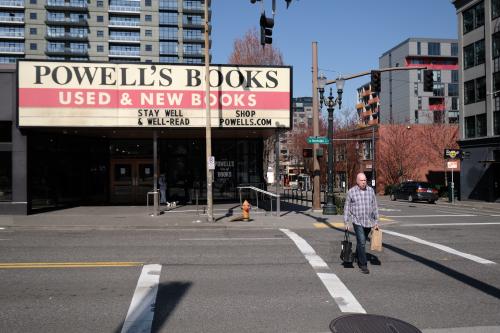The economic impacts of COVID-19 are already shaping up to be significant, yet uneven, across the country. Not only are workers and businesses affected, but so too is the fiscal capacity of governments that rely on a healthy economy for their revenue. As the crisis unfolds, the impact on cities’ bottom line will be driven not only by overall economic conditions but specifically the parts of the economy where revenue is generated: retail sales, income and wages, and real estate.
To understand when cities can anticipate the brunt of COVID-19’s impact on their general fund revenues, we examined the extent to which a city relies on general tax sources that respond quickly to economic swings. An important factor is whether the city’s underlying regional economy is composed of industries that are more immediately exposed to coronavirus-related employment declines.
The results indicate an uneven geography of fiscal impact, with many heartland cities likely to be hit harder and more quickly than others.
A city’s tax structure will affect its short-term outlook
Cities in the U.S. generate the majority of their revenue by designing their own tax and fee structures within the limits imposed by their states (e.g., property tax limits, debt limits, constraints on access to some tax sources). As a consequence, cities’ tax structures vary across the country, with some relying heavily on property taxes and others primarily on sales taxes. Only a few cities—approximately one in 10—rely most on income or wage taxes.

Federal aid amounts to some 5% of total municipal revenue, while state aid is 20% to 25%. In other words, a city’s tax structure accounts for 70% to 75% of what it can spend to meet the health, safety, and welfare needs of its residents and visitors.
After less than a month of shelter-at-home edicts, it’s clear that retail sales have plummeted and unemployment is skyrocketing. A city that generates the majority of its revenue from sales or income taxes will be hit hard and immediately when it experiences such consumer declines and job losses.
A city that relies on property taxes, however, will not experience such an immediate collapse in its revenues. Local assessment practices require that cities wait to estimate the value of land and property until the property is exchanged on the market or an assessment is conducted. Current property tax bills, therefore, typically reflect values of the property anywhere from 18 months to several years prior to collection. Property tax collection is less responsive, or “elastic,” in the short term—but over time, as rising unemployment dampens real-estate demand, even these property-tax-dependent cities will feel COVID-19’s impact.
In addition to taxes, approximately one-third of city-sourced revenues are derived from fees and charges for services such as trash collection and water. Although COVID-19 will adversely affect some fee-driven services (think transit and parking) because demand is reduced, it will affect other services (water, sewer, etc.) less severely, as residents remain in place and continue to use them.
Local industries will play a role, too
To illustrate the impact of tax structures on city-revenue responses to COVID-19, we evaluated the share of regional employment in high-risk industries (mining/oil and gas, transportation, employment services, travel arrangements, and leisure and hospitality) and the share of general fund revenues from sales and income taxes across 139 cities. These cities are diverse in their geographies, economies, and revenue structures.
Cities with both a vulnerable economic composition (greater than 15% share of employment in high-risk industries) and a tax structure that is highly reliant on elastic sources of revenue (greater than 25% share of general fund revenues) will feel a dip in revenues more quickly than those with alternative economic and fiscal structures.
This analysis reveals that many of the most fiscally impacted cities in the shorter term are in America’s heartland. For example, 76% of Columbus, Ohio’s general fund comes from income taxes, and 16% of regional employment is in highly vulnerable industries. Cities in Ohio rely heavily on the flat income tax, which correlates immediately to changes in employment.
In places that rely heavily on sales taxes—such as Tulsa, Okla., Lincoln, Neb., and Denver—the closing of retail sales outlets will generate an immediate reduction in city revenue. Oklahoma City’s sales tax contributes 54% of its general fund revenues, for example, while 20% of its workers are in vulnerable industries.
A reliance on income taxes (as in Columbus) or sales taxes (as in Oklahoma City) will generate a strong shock to a city’s fiscal system as the COVID-19 pandemic continues. The fiscal impacts will likely appear within a month or two, and require those cities to adjust their budgetary expenditures in short order.

Those cities likely to feel mid- to longer-term impact are more reliant on property taxes and have a less-exposed local economy. Durham, N.C., for example, does not have a local sales or income tax, and less than 12% of regional employment is in high-risk industries.
It is possible, however, that foreclosures in property-tax-dependent cities (due to unemployment and the inability to pay taxes and mortgages) might happen more quickly than anticipated, driving property tax revenue down sooner than the typical 18 to 24 months.
The immediately impacted cities—those reliant on sales and incomes taxes with a high share of vulnerable industries—are likely to feel fiscal declines within the next month or two. Others are more likely to feel COVID-19’s economic effects in the next few quarters to a year. Although higher reliance on property tax revenue is generally more favorable in the short term, a less-diversified structure will limit the resilience of city budgets in long term.
Strong Intergovernmental Partnerships are Vital
The fiscal capacity of local governments to manage public health and economic resilience in the face of COVID-19 is uncertain at best. The federal government has committed to providing much-needed assistance to cities to meet the immediate needs of residents, households, and small businesses on the economic margins. This includes expanded funding for Community Development Block Grants, transit, education, broadband, and housing and homelessness. Notably, cities with a population over 500,000 will also receive direct financial assistance via a stabilization grant program, the Coronavirus Relief Fund.
Unfortunately, the potential impact on most local budgets is largely unknown, because states will have maximum discretion to allocate resources to cities as they see fit based on population size. Future federal bills should consider much lower population thresholds for direct local funding.
Under the current bill, states and cities should coordinate in unprecedented ways to ensure that measures of local fiscal capacity—including tax structures and the share of high-risk workers—are considered in funding distribution.
States should also allow their local governments to modify tax structures so they are in line with their underlying economic bases. Flexibility to collect a better mix of sales, income, and property taxes will offer cities the tools they need to respond in the short and long term as economic conditions and the needs of their residents change. This flexibility will be especially important in the months ahead, as state revenues and aid to cities begin to take a hit.
American cities will face very different situations as COVID-19’s economic impact becomes clear. The most effective solutions to this unprecedented situation will take into account the uneven magnitude and timing of the fiscal impact that cities will experience across the country.







Commentary
When will your city feel the fiscal impact of COVID-19?
March 31, 2020